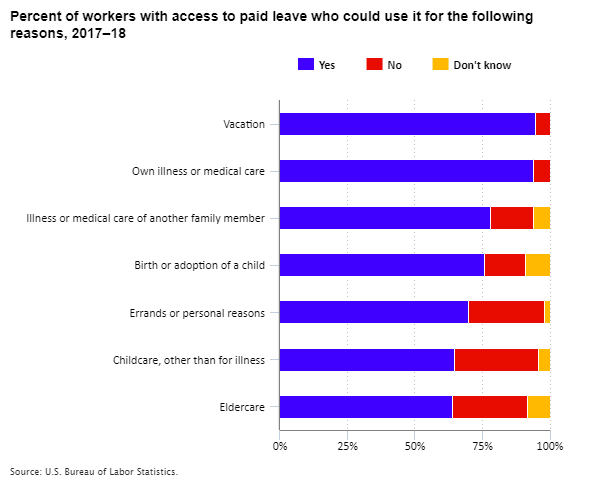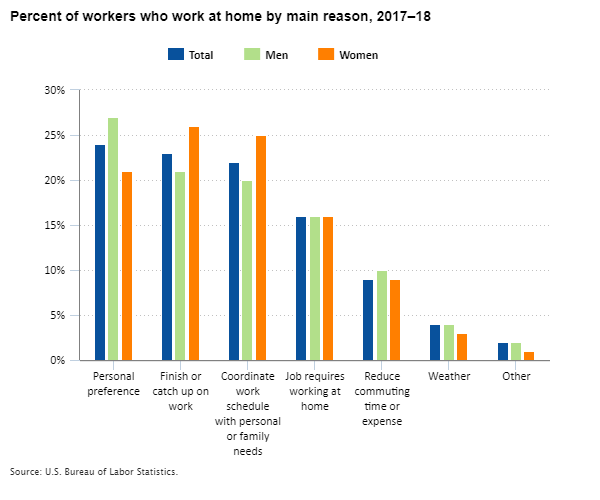Among the many challenges for today’s families is the balance between caregiving and the demands of working outside the home. Some workers are even sandwiched between the need to provide both childcare and eldercare. New information from the Bureau of Labor Statistics shows that about two out of three employees have paid time off available to meet these needs.
Interest among federal, state, and local policymakers in paid time off and other job flexibilities motivated the U.S. Department of Labor’s Women’s Bureau to sponsor an extra set of questions in the American Time Use Survey. The 2017–18 Leave and Job Flexibilities Module gives us data on the characteristics of wage and salary workers who have access to paid and unpaid leave in their jobs. The module also asked questions about workers who work at home and whether they have flexible work schedules. We also know more about workers who do not have access to leave and job flexibilities. Because we collected the data directly from workers, we could ask them about their experiences, such as the reasons they take leave, or don’t take it even when they need to, and why they work at home.
We now know that 66 percent of U.S. wage and salary workers were able to take paid leave from their jobs in 2017–18. Workers were most often able to use paid leave for a vacation and if they were sick or needed medical care. One area of interest is about people who provide unpaid eldercare. The survey showed that 64 percent of eldercare providers who were employed were able to use paid leave to provide elder caregiving. Another 28 percent of these caregivers were not able to take paid leave for this reason, and 8 percent didn’t know if their employer would allow them to use paid leave to provide eldercare.

Editor’s note: Data for this chart are available in the table below.
We also have learned that 36 million workers (25 percent) sometimes worked at home, and they did so for different reasons. Twenty-four percent worked at home because of a personal preference, 23 percent did so to catch up on work, 22 percent worked at home to coordinate their work schedule with personal or family needs, and 16 percent did so because their job required it. Among those who sometimes worked at home, men and women had different reasons for doing so. Women were more likely than men to work at home to finish or catch up on work and to coordinate their work schedule with personal or family needs. Men were more likely than women to work at home because of a personal preference.

Editor’s note: Data for this chart are available in the table below.
We published these results and more in two recent news releases. One news release focused on workers’ access to leave, their use of leave, and an unmet need for leave. The second focused on workers’ job flexibilities and work schedules.
These releases present data on:
- Access to paid and unpaid time off
- Use of paid and unpaid time off
- Needing to take leave from a job but deciding not to take it
- Flexible work hours
- Knowing work schedule in advance
- Working from home
The releases provide information by:
- Gender
- Age
- Race
- Hispanic or Latino ethnicity
- Educational attainment
- Full- or part-time status
- Earnings
We also have data files that allow researchers to analyze the data and gain even more insights. Following the policies of BLS and the U.S. Census Bureau to protect the privacy of survey respondents, these data files do not have any information that could identify individual participants.
| Reason | Yes | No | Don’t know |
|---|---|---|---|
Vacation | 95% | 5% | 0% |
Own illness or medical care | 94 | 6 | 1 |
Illness or medical care of another family member | 78 | 16 | 6 |
Birth or adoption of a child | 76 | 15 | 9 |
Errands or personal reasons | 70 | 28 | 2 |
Childcare, other than for illness | 65 | 31 | 4 |
Eldercare | 64 | 28 | 8 |
Note: The estimates for “childcare, other than for illness” are for workers who were parents of household children under age 18. The estimates for “eldercare” are only for workers who were eldercare providers. | |||
| Reason | Total | Men | Women |
|---|---|---|---|
Personal preference | 24% | 27% | 21% |
Finish or catch up on work | 23 | 21 | 26 |
Coordinate work schedule with personal or family needs | 22 | 20 | 25 |
Job requires working at home | 16 | 16 | 16 |
Reduce commuting time or expense | 9 | 10 | 9 |
Weather | 4 | 4 | 3 |
Other | 2 | 2 | 1 |
 United States Department of Labor
United States Department of Labor